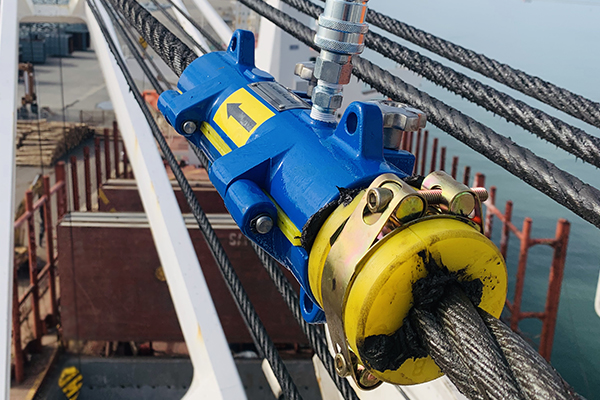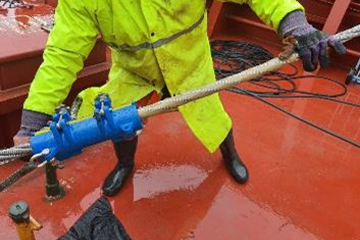Wire Rope Lubrication: The Complete Guide for Safety & Longevity
Wire ropes play a critical role in numerous industries, but without proper maintenance, their service life and safety can be significantly compromised. Regular lubrication, in particular, is the single most important process for maintaining peak performance and protecting wire ropes from corrosion and wear.
This guide, based on recommendations from world-renowned authorities like Chevron, OCIMF, and ISO, outlines the most effective lubrication methods to extend the service life of your wire ropes and ensure operational safety.


Why is Wire Rope Lubrication Important?
Far more than just applying oil to the surface, proper lubrication is a crucial preventative maintenance activity that protects both the interior and exterior of a wire rope.
Corrosion Prevention and Service Life Extension
According to the OCIMF MEG 4 guidelines, proper lubrication is the most effective way to protect wire strands from moisture and corrosive elements.
"Corrosion affects the residual strength of a wire but it can also affect the wire ductility and other mechanical characteristics and may shorten the service life."
Wear Reduction
The ISO 4309:2017(E) standard states that lubricant minimizes the friction generated as individual wire strands move against each other, thereby reducing wear.
A "lack of lubrication... can also affect the rate of wear."
Ensuring Maximum Service Life
As stated in Chevron's technical information, lubrication is not optional, but mandatory.
"...To obtain maximum service life, ropes should be relubricated at regular intervals."
The 3-Step Process for Proper Wire Rope Lubrication
A systematic approach is required to achieve the best results. The following 3-step process maximizes the effectiveness of wire rope lubrication.
-
Step 1: Thorough Cleaning
Before applying a new lubricant, it is essential to get the rope clean. As per Chevron's recommendation, "Before lubrication, a rope must be cleaned with wire brushes, a scraper, compressed air, or superheated steam." Old layers of lubricant and dirt can prevent the new lubricant from penetrating the rope and may even cause abrasive wear. If necessary, these layers should be completely removed using a suitable solvent.
-
Step 2: Effective Lubricant Application
The core goal of lubrication is for the lubricant to penetrate deep into the rope's core. Chevron strongly recommends using a high-pressure lubricator. A high-pressure lubricator helps the lubricant effectively penetrate past the outer strands and into the rope's core. This ensures that the unseen internal wires are also protected from corrosion and friction.
-
Step 3: Regular Relubrication
Lubrication is not a one-time job. ISO 4309:2017(E) emphasizes that regular inspection and relubrication are crucial. "During the life of the rope, and before it shows any signs of dryness or corrosion... the rope shall be dressed from time to time, as determined by a competent person." It is crucial to regularly inspect the rope's condition, usage environment, and frequency of use, and relubricate immediately when necessary.
Managing Wire Ropes in Storage
A rope that is not in use still requires maintenance.
Periodic Inspection
In accordance with ISO 4309:2017(E), ropes in storage shall be checked periodically for any signs of deterioration, such as surface corrosion. If deemed necessary, a suitable preservative or lubricant that is compatible with the manufacturing lubricant should be applied.
Tip to Prevent Drainage
In warm environments, lubricant can drain from the rope due to gravity. To prevent this, "the reel should be periodically rotated one half-turn to prevent drainage of lubricant from the rope." This is a highly practical tip to keep the lubricant evenly distributed throughout the rope.
Frequently Asked Questions (FAQ)
Q1: How often should a wire rope be lubricated?
A: There is no fixed interval; it is determined by a competent person. It is best to consider the rope's operating environment, load, and frequency of use, and to relubricate immediately upon observing any signs of dryness or corrosion.
Q2: Is it necessary to clean a wire rope before lubrication?
A: Yes, it is essential. Both Chevron and ISO stress the importance of cleaning. Removing old contaminants and hardened lubricant is the only way to ensure the new lubricant can properly penetrate the rope's core and perform its function.
Q3: What is the best method for wire rope lubrication?
A: Chevron recommends using a high-pressure lubricator as the most effective method, as it ensures the lubricant penetrates deep into the rope's core for complete protection.
The Optimal Solution: The SaeMah Wire Rope Lubricator
Thorough cleaning, core-penetrating lubrication, and regular maintenance, as outlined in this guide, are essential prerequisites for the service life and safety of wire ropes. SaeMah's Wire Rope Lubricator integrates all of these processes into a single system, providing the ideal lubrication solution recommended by authorities like Chevron and ISO. The right choice of equipment determines the value of your wire rope.

 ENGLISH
ENGLISH


